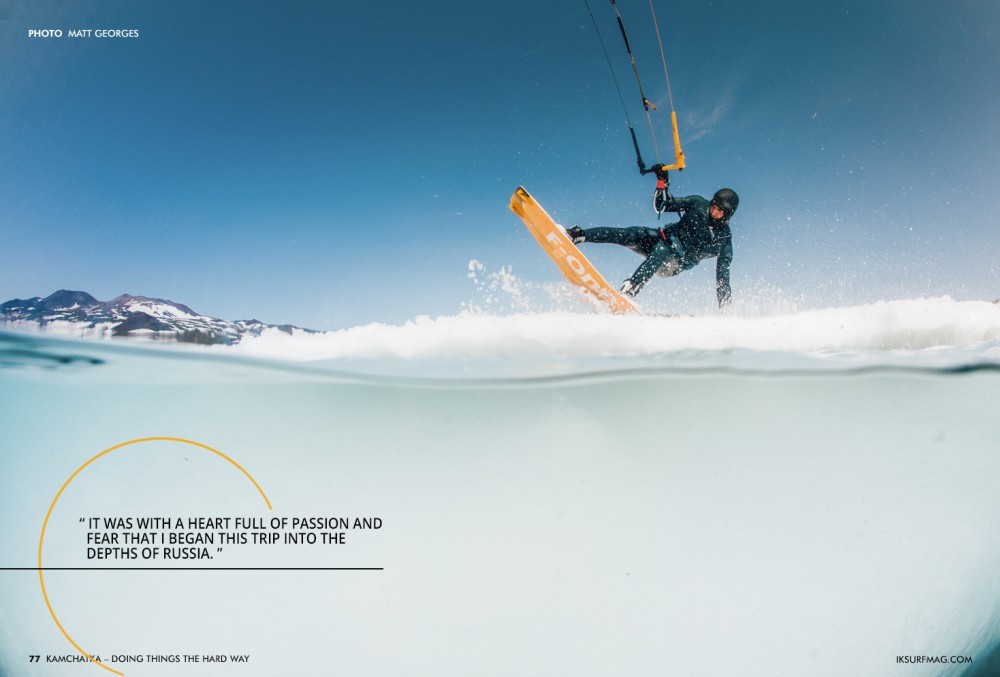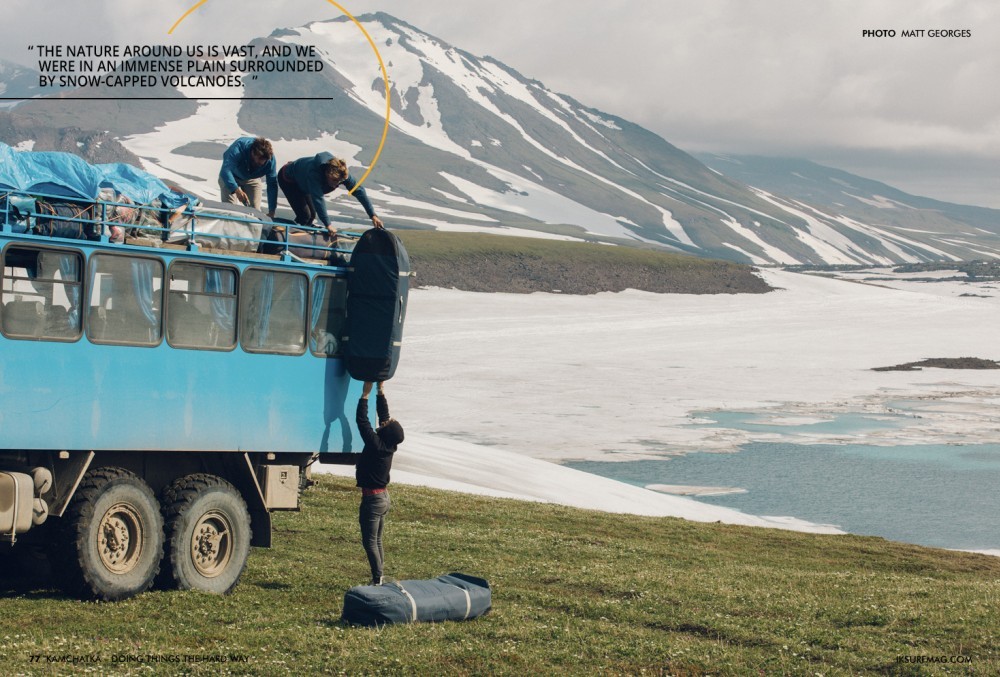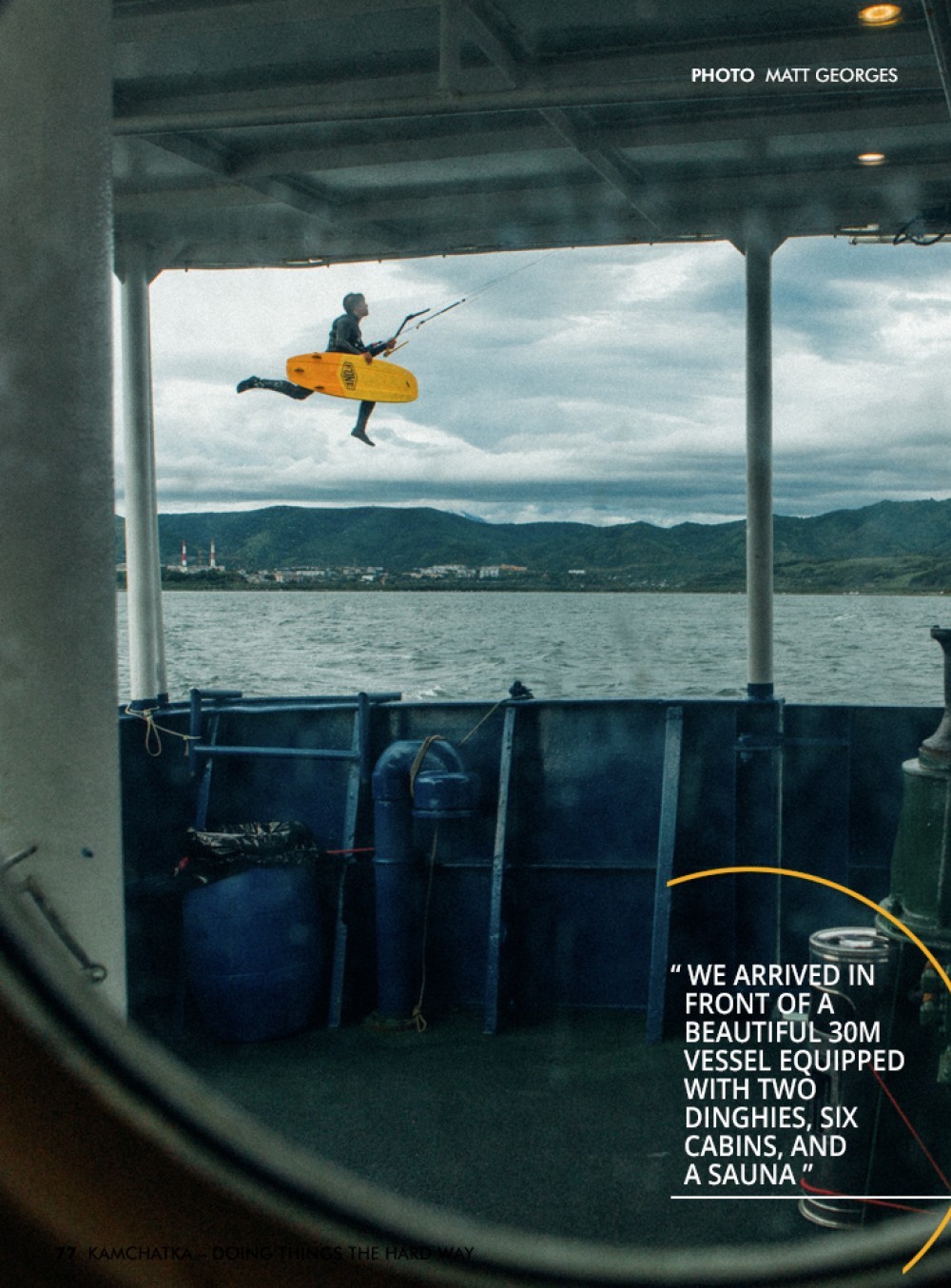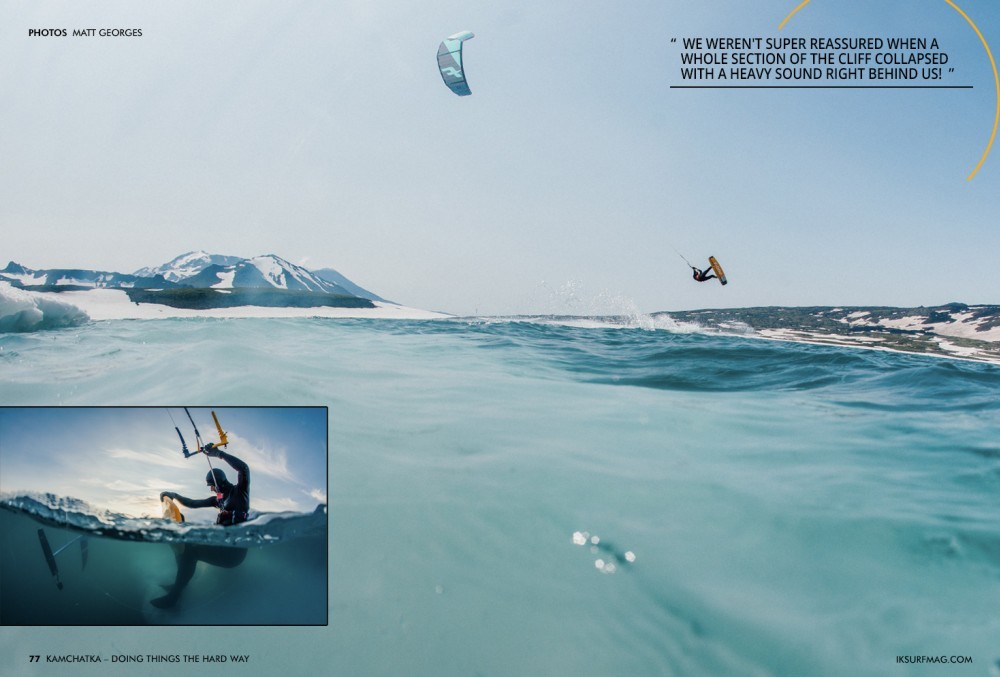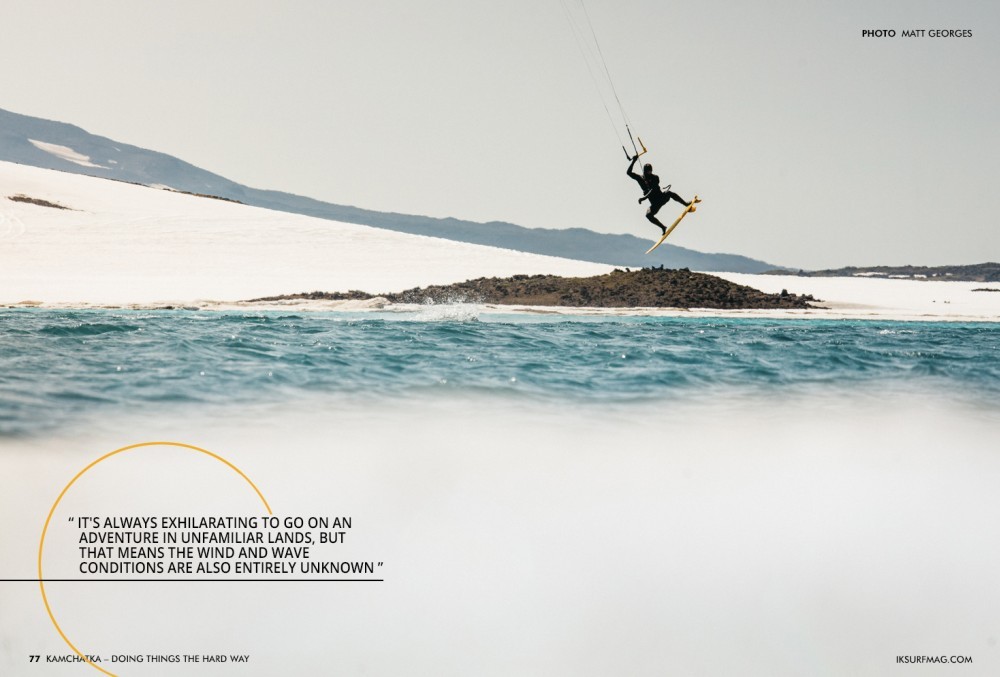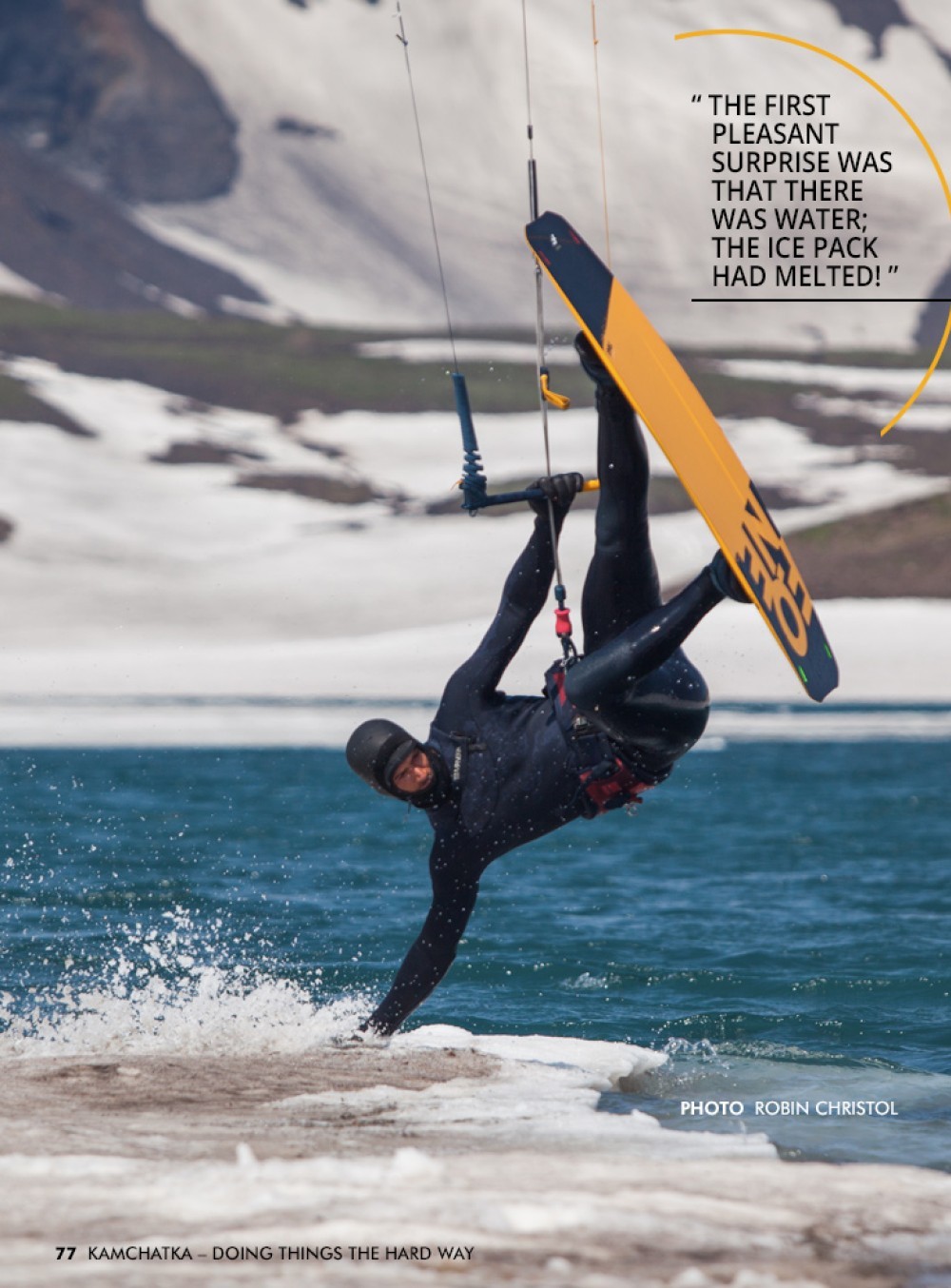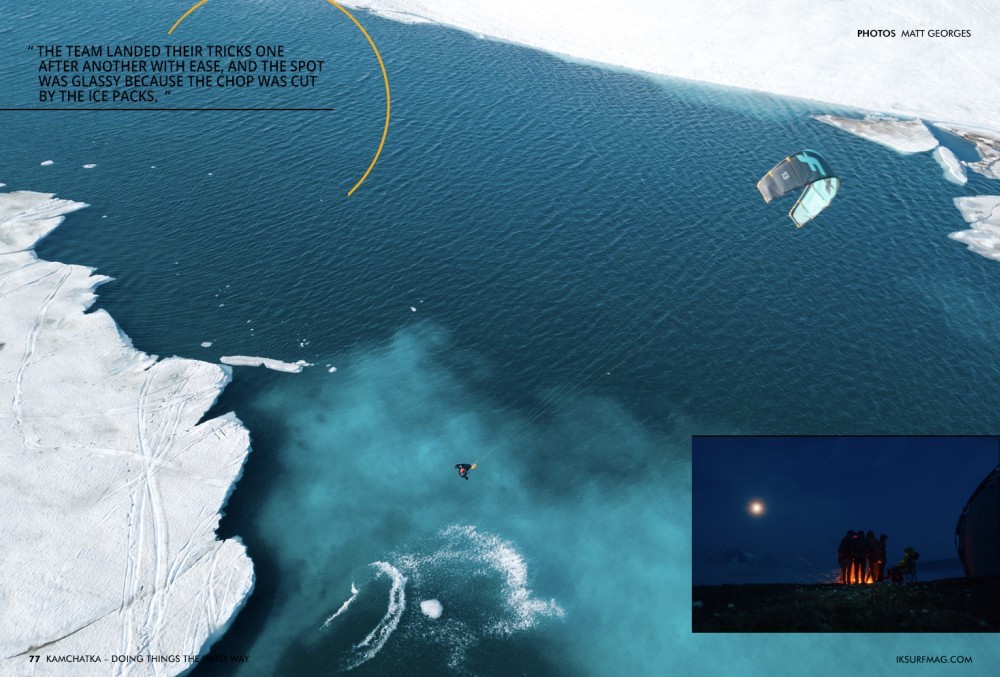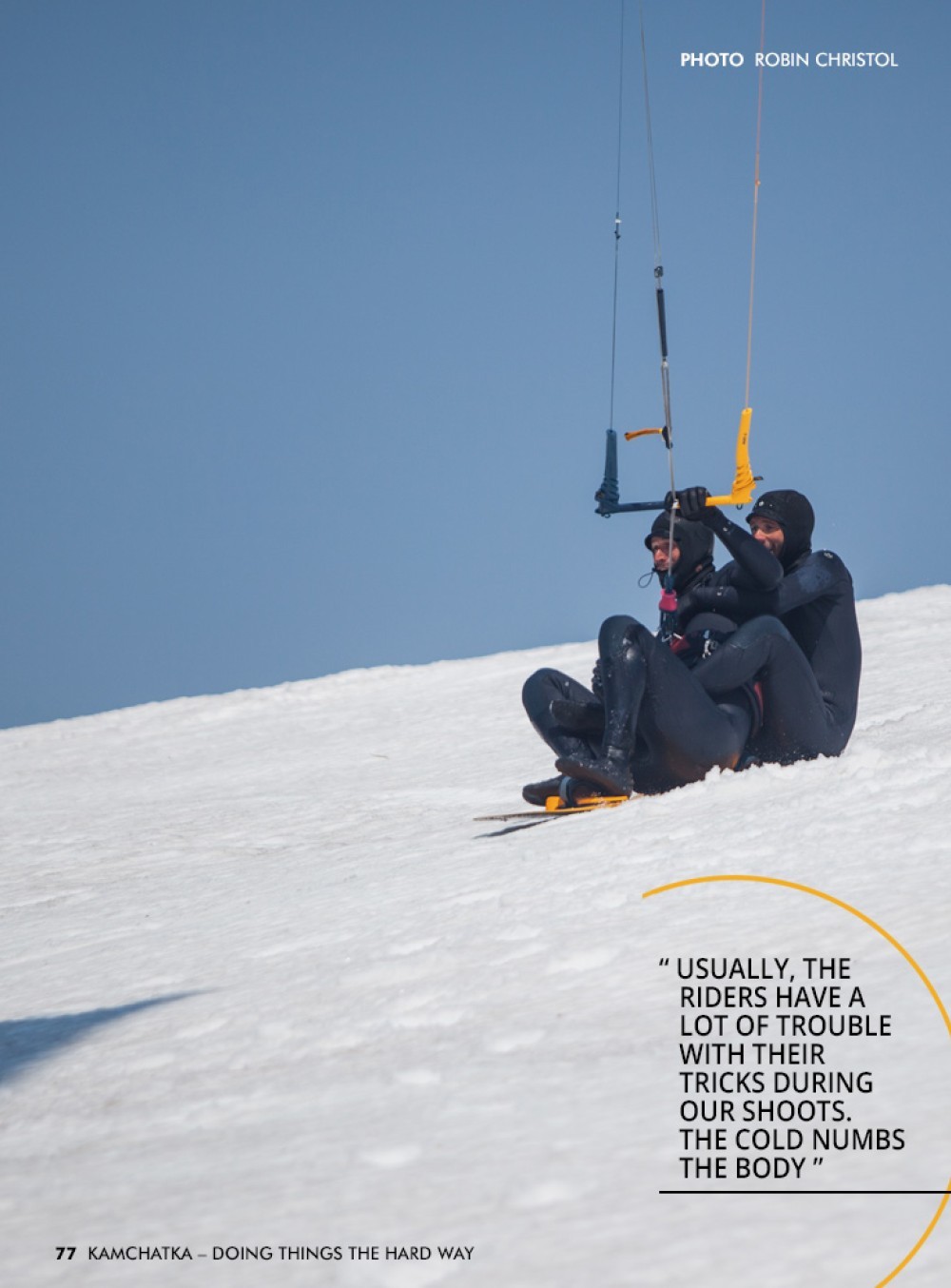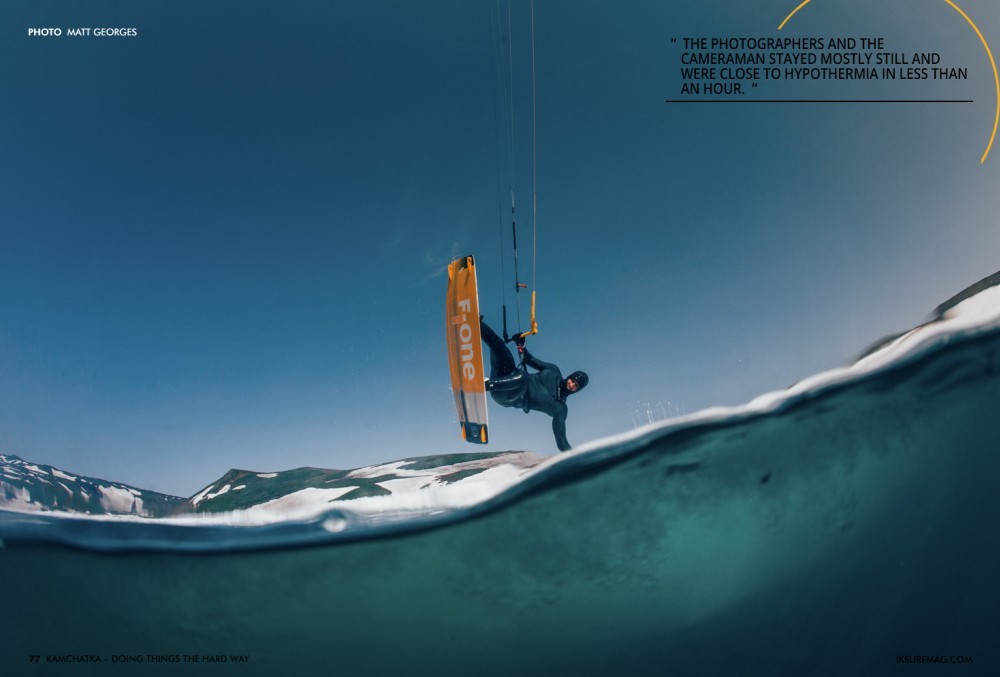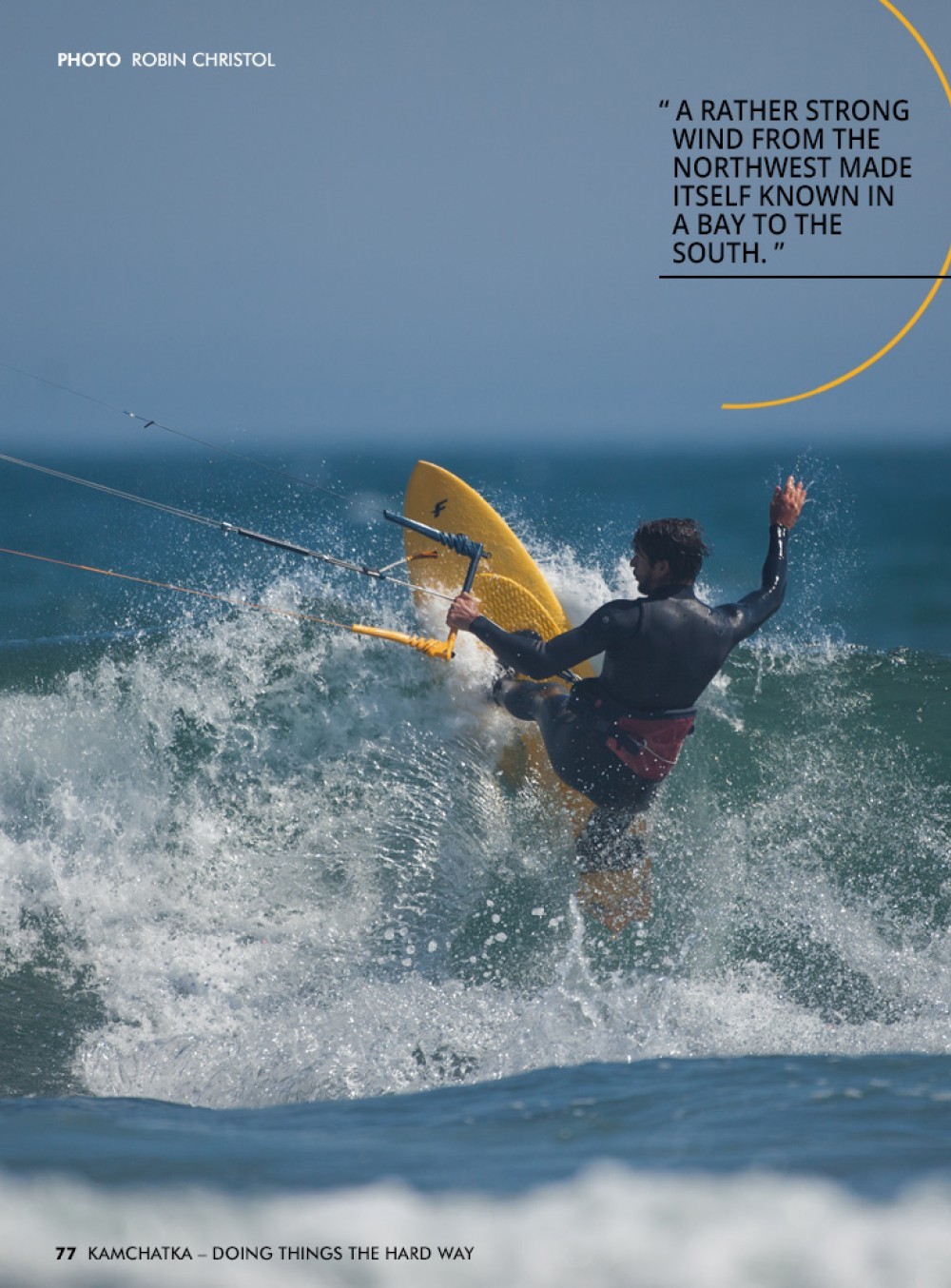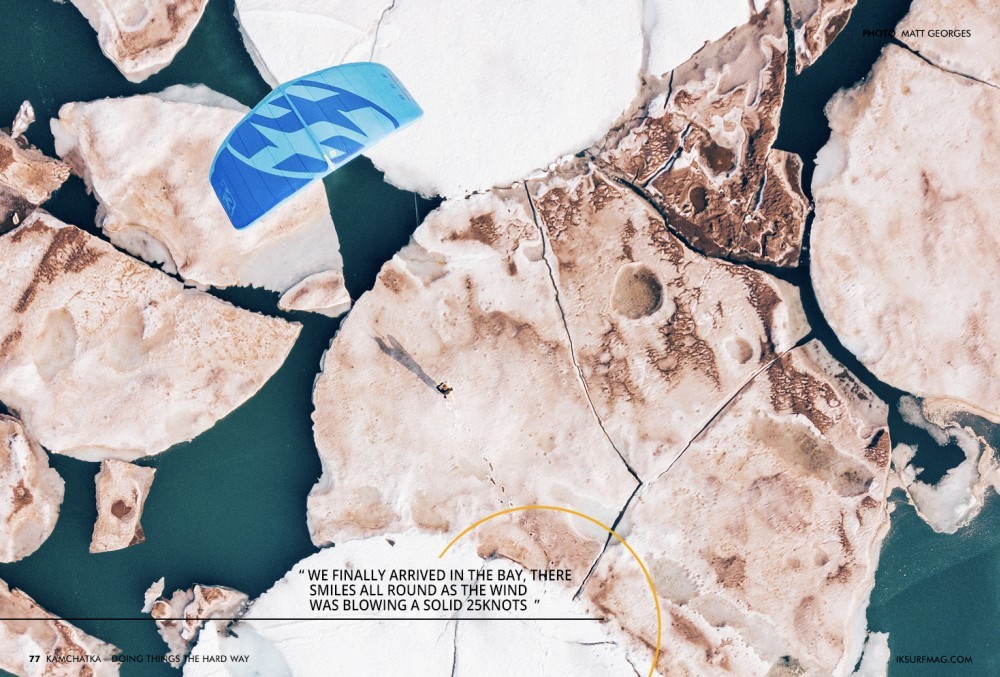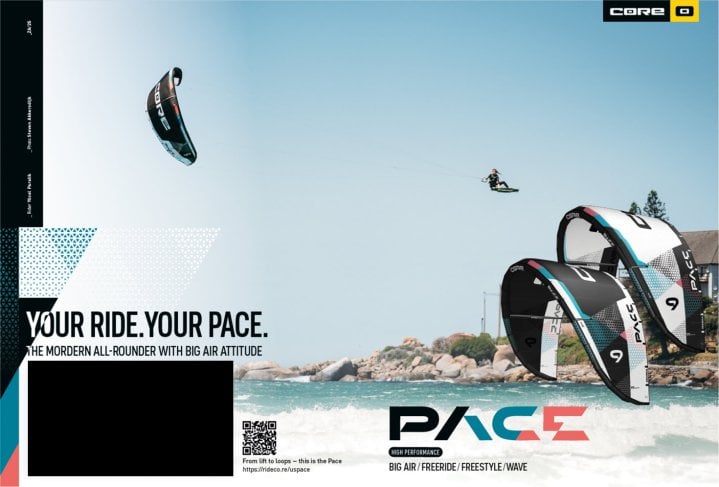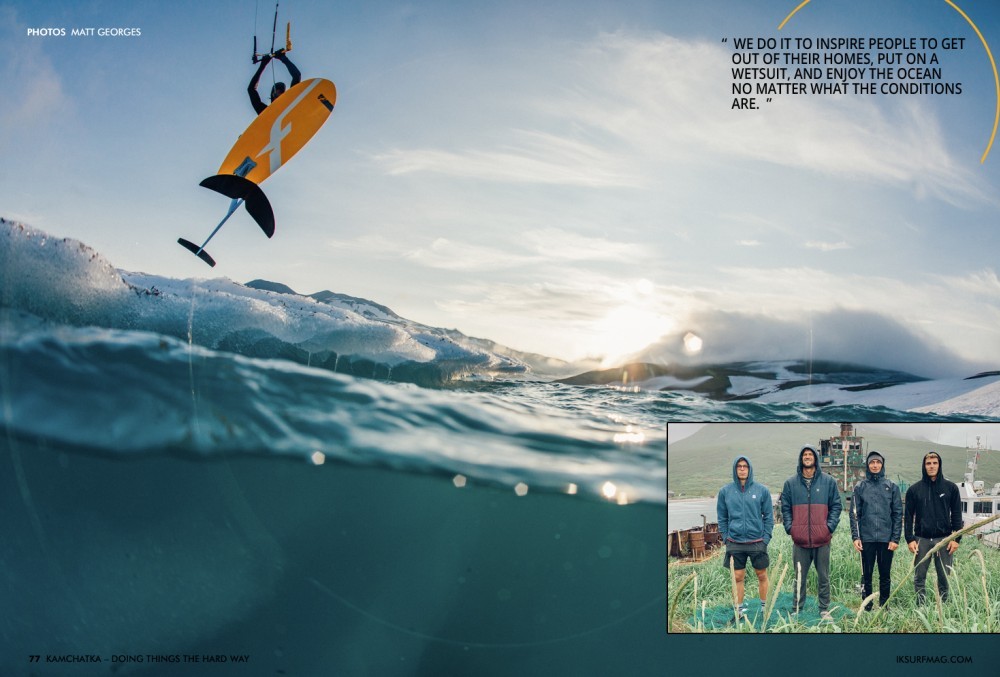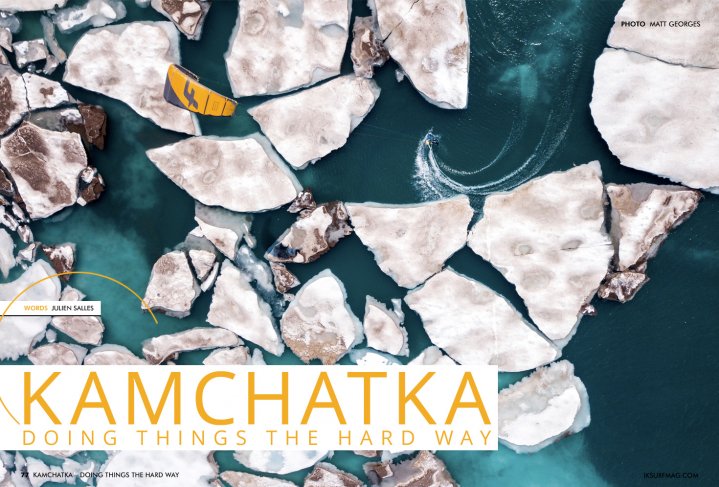
Kamchatka The Hard Way
Issue 77 / Mon 14th Oct, 2019
Some trips aren't easy, but Kamchatka might just take the crown after taking four years to pull together! The Manera team take it in their stride as they travel into deepest darkest Russia to battle the cold and sample the homemade vodka.
Julien Salles isn’t your usual brand manager, when it comes to running Manera he’s always searching out the most difficult and challenging spots to go to for the shoot. After hearing about this wild wilderness in the far east of Russia he knew he had to take the team there, however, it was to prove a lot harder and more challenging that it looked!
Four years. This is how long it took to gather and coordinate the four Kamchatka photoshoot essentials: The best local team, four world-class riders, logistics (visas, permits, tickets, boat, tents, vehicles etc.), two photographers and a cameraman with unwavering dedication.
After all these years, I had this bad feeling that I was expecting too much, that only disappointment awaited me. The same feeling you get before a New Year's party full of false resolutions. So, it was with a heart full of passion and fear that I began this trip into the depths of Russia.
Located in the far east of Russia, Kamchatka is a huge volcanic peninsula covering 270,000 km². It was classified as an "ultra-secret" military zone at the end of World War II, and the peninsula was therefore closed to visitors until the 90’s. This has preserved the authenticity of the place and nature there has remained almost intact. Special permits are needed to venture from the capital, and there is little to no infrastructure to get around.
The Pacific coast receives swell and wind, and it was there that we would be hanging out.
The Team
Mallo is the veteran. After a busy riding career, he is now a head judge on the world freestyle tour. He was there for the waves, which he rips with the mastery of an experienced surfer.
Paul is a pure freestyler. After having spent five years on tour, he is one of the most experienced riders. I'm counting on him for some big air/kiteloops if the wind is strong.
Camille is one of the world's top 5 strapless riders. He's been on all the MANERA trips, and every year his bag of tricks evolves - all he needs is 20 knots, and he can do anything!
Max, the young freestyle prodigy, a regular on the podium at the GKA Freestyle World Tour events. At only 19 years old, he has demonstrated great maturity and has a massive passion for the sport.
The team was chosen not only for their performance on the water; they are humble and polite people, and especially passionate about adventure. They master all the disciplines of kitesurfing and are happy to go into the water no matter what the conditions are.
Logbook
After an 8-hour flight from Moscow, we landed at Petropavlovsk-Kamchatsky, the capital of Kamchatka. We crossed the city to meet up with the Omega, a Japanese military ship that was converted into an expedition ship.
The contrast between the city and nature is striking. The buildings are cubic, with few openings, and very often in bad shape. It’d a cold yet effective Soviet style, nothing extra is added for comfort. The nature around us is vast, and we were in an immense plain surrounded by snow-capped volcanoes. It was very green; we got the impression that it rained a lot. This contrast gave an apocalyptic dimension to the city, which made everything charming. We crossed a military port where old, rusty warships were piling up, and then we finally arrived at our boat. The crew was waiting for us, and we met our local guide. Our guide wasn't an old, bearded, tattooed sea dog as we expected, but instead a petite brunette in her thirties: Kristina. Don't get me wrong! She was born in the Kuril Islands, runs a team of six sailors, knows how to drive almost any motorised machine, a VIP in the best club in town, and she makes her own vodka! She runs the Peleken agency, which was crucial for the success of the trip.
The Omega
We did not really know what to expect with this ship, especially having seen the condition of the harbour's other ships. Imagine our surprise when we arrived in front of a beautiful 30m vessel equipped with two dinghies, six cabins, and a sauna. After loading the board bags and strategically choosing our cabins to avoid the loudest snorer (whose name I will not mention), we finally set sail.
The first meal was a salmon feast, an opportunity to settle down and look at the forecast before cutting off all contact with civilisation. The Windguru board displayed a white to light blue colour: Less than 10 knots every day; things were looking rough. We checked the map for any bay that could accommodate a Venturi effect (wind acceleration), but we had no luck. We took advantage of the opportunity to ride foil surfs and spend time on the water. The waves were strangely docile even if the swell had an extended period. The take-off was easy, and the swell reformed for a long time.
There was always a volcano behind the spot; it was as if we were in another world. For the last session, we got into the water at the end of a cape on a sort of mini-slab far at sea. We weren't super reassured when a whole section of the cliff collapsed with a heavy sound right behind us! Getting out of the water, we sailed for five minutes by boat, and we ran across a pod of killer whales near where we surfed. There is definitely something brutal and rough about this coast!
Despite all our efforts to find wind, we spent four days without inflating even one kite, until a squall came through. We were filming Max skiing in a fjord when we saw clouds bringing in 20-25 knot winds. We threw ourselves in the dinghies and rigged the gear as soon as possible, knowing that these types of conditions only usually lasts 20-30 minutes. We headed to the beach with the film crew, and Max and Paul struggled to follow because the wind wasn't stable yet, the kites were wobbling, falling, but the wind finally came back, and we started filming. The dinghy went back to the Omega, and we stayed alone on the coast:
"Did anyone bring the bear repellent?"
"No."
The guys filmed and took photos while I watched the plain behind us to avoid any unpleasant surprises. Kamchatka has a very dense brown bear population, of which the locals are wary, so we were constantly watching our backs.
We only filmed for 20 minutes, but we were happy, and this allowed us to get at least a couple of action shots. It's always exhilarating to go on an adventure in unfamiliar lands, but that means the wind and wave conditions are also entirely unknown, so it's hard to score. This means each short session is a success.
The next day, we stopped to fish in a lake, when two poachers approached us. They had hard, cold, and damaged faces; one was carrying a machete and the other one a rifle. They dropped their weapons and explained that their boat had broken down and they had been stuck out there for three days. We decided to help them but took away their weapons for precaution. We finally dropped them off at a poachers' camp a few hours away. They seemed to know each other and hugged each other heartily. We probably saved them, but to be honest, it was not a reassuring encounter.
It was towards the end of our boat trip, and we headed back to the port in Petro. The last five days had been incredible, but we are still missing action shots, and Windguru had no good news for us. The stress started to rise. We overheard a local talk about an extinct volcano that housed an ephemeral lake in its crater. It is an ice pack all winter, but it melts for three to four weeks in July and finally disappears in August. Apparently, the timing was good. We decided to try our luck, and we rented a 6x6 military vehicle without really knowing what we were getting into.
We spent the night in town before leaving, and our guide suggested that we go out for drinks. After a few shots of her homemade vodka, we left the club in a hurry, chased by a group of angry Russians and their girlfriends who had apparently fallen in love with the riders!
The Pyramid of Fire
The next day, we loaded the Soviet vehicle and left for 6-hours of very rough terrain, moving in all directions, and that clearly did not help our hangovers. After driving for a bit on the snow, we arrived above the crater. The first pleasant surprise was that there was water; the ice pack had melted! The second pleasant surprise: it was blowing a consistent 15 knots!
Paul and Max got out the gear and ran to the water, carving down the long snowy slope to the lake. The filming crew slid down as far as they could. The sun was low, and the light was perfect, the team landed their tricks one after another with ease, and the spot was glassy because the chop was cut by the ice packs. They picked up speed on the snowy slope to send their biggest tricks, they slid on the icebergs, the scene was unreal, and the ambience was festive that evening! It was still too early to drink another beer, but we shared a good meal around the fire, and it was pure happiness.
The nights on the boat were very comfortable, but when we got back to the tents that night, it was something completely different: the humidity had soaked everything, the wind was still blowing, and the wet tent was flapping in our faces. It was cold... very cold. As I was finally falling asleep, I heard loud music start up a few meters from the tent; heavy dubstep. We were the only humans for miles around, so it was, of course, one of us. I told myself it was a mistake and that it would be turned off, but the music stayed on all night, as loud as it was when it started.
The next day, we learned that bears often frequented the place and that they started looking for food at night. The music deters them from approaching (personally, that dubstep would have made me flee too). So we had a restless night, but at least no bears came rummaging nearby. On the other hand, we found big, fresh footprints below where we had filmed the day before.
The following day, the wind was still there, it was very steady, a kind of thermal wind created by the difference between the 2°C water and the air that could reach 15°C during the day. Usually, the riders have a lot of trouble with their tricks during our shoots. The cold numbs the body, the conditions are often unpredictable, and the hood, gloves, and boots do not help to grab the bar, but here they were able to do everything. It was as if we were in Brazil (with 25°C less).
We took advantage of the conditions by shooting from the bank, by drone, and from the water. The riders comfortably stayed on the water for 2-3 hours, but the photographers and the cameraman stayed mostly still and were close to hypothermia in less than an hour. You have to choose the right moment! While the freestylers were shooting, Mallo and Camille had fun playing with the icebergs, gliding/flying along the slope, cutting the ice with their foil; the playground had great potential for fooling around!
When we returned in the evening, a not-so-shy fox came to visit. He came to steal some salmon from us. It was Mallo's birthday, so of course, we had to drink again; we didn't have any alcohol, but the drivers offered us a pink beverage contained in plastic bottles that they called "spirit". We didn't have a choice. We tried it in spite of our guide's reluctance.
Our 6-hour drive back was quite similar to the previous one...
Black Sand
We were back in Petro. We finally got an Internet connection, and we had to decide on a plan for the remaining five days. Windguru still had nothing good to say, but the weather was nice and warm (around 20°C in the afternoon), so we bet on a thermal wind. We left for the most exposed coast, a huge volcanic sand beach north of the city. No time to rest, we went from a military vehicle to a 4x4 to chart our way forward.
The beach was huge, dominated by three volcanoes, including one active one. A river ran right next to the camp, perfect for fishing and cooking. The meadow behind the beach is very rough with big craters. A local explained to us that they were created during the last explosive eruption of the volcano. In the meantime, they made great restrooms!
We hardly had time to set up the camp, the thermal rose with a beautiful 15-knot side-on and a rather fun little swell. It was time to get into the water for Mallo and Camille. I knew they had been dying to do their job since the beginning of the trip. It was hard to watch the freestylers bingeing on the flat when we had already spent ten days without being able to film any waves or strapless action. In front of the volcanoes, they surfed waves one after another until nightfall, accompanied by a few seals curiously watching their new neoprene companions.
We lit a beautiful bonfire to warm them up, and it was too late when we noticed that the ground under our tents was very uneven. It looked like another excellent night to come!
Since it was too difficult to sleep, we got up at 5am to surf-foil. The waves were glassy, the wind was offshore, and the sun rose. We found new bear tracks on the beach; this one was a smaller bear. We looked for the bears all throughout the trip but found none. It was quite frustrating to be in bear-land without seeing a single one! That being said, thanks to the prints, we know that they had probably seen us.
We spent three days surfing in the morning and kiting in the afternoon, but one of the guys managed to get some signal and a rather strong wind from the northwest made itself known in a bay to the south. Our guide agreed to take the boat over, and we swung into action to reach the port as quickly as possible. We needed a 4x4 and rented a tow truck to bring all the equipment.
It got bogged down seven times on the road, and we had to push and retrace our steps so many times, but we finally arrived in the bay, there were smiles all roundas the wind was blowing a solid 25knots. We were in the open sea at the exit of the bay, the spot was rather hostile, but Camille and Mallo were ready to go. We just needed to take off, launching from the boat was difficult since it moved a lot. We tried several techniques, the kite first, the rider first. The latter seemed to be the most effective, even if it was hard to throw yourself from the deck into the icy water.
It was time for me to change, and as I passed the living room, I saw Camille landing a big frontroll through one of the portholes; and that was it, off we went. They landed all their tricks while Paul was boosting some hang-time over the volcano. Camille did a series of doubles, backs, kiteloops one after another, but when he starts doing board-off we hear someone shout:
"Hey, what the %#*! are you doing?!"
It was Olivier the cameraman who "gently" reminded him of the rule: Strapless board-offs were banned. They laughed, and Camille did other tricks.
We sailed to Petropavlovsk to spend our last night in Russia, and I looked back on these last two weeks. Was I expecting too much? Definitely not; Russia spoiled us with beautiful landscapes, encounters, wind, waves, and certainly a little too much vodka. Iceland, Canada, Scotland, Russia, each trip reinforces my belief that our sports are more than just summer sports and that braving the cold is something unique, even necessary for some.
Experiencing a beautiful adventure between friends in the cold is worth it, even with the hours of bad sleep, frozen fingers, a certain discomfort, and all the efforts to be at the right place at the right time.
We do it to inspire people to get out of their homes, put on a wetsuit, and enjoy the ocean no matter what the conditions are. Every moment spent in the water should be magical. Stay salty
Videos
By Julien Salles




